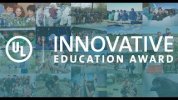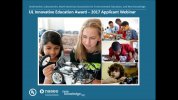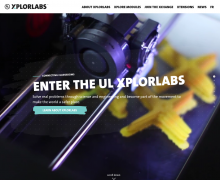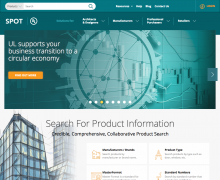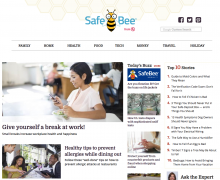The UL Innovative Education Award is a first-of-its-kind initiative designed to invest up to US $250,000 annually in environmental and STEM education, sustainable communities, and youth empowerment. We offer recognition awards to increase the impact of existing innovative non-profit programs that use the Environment as a pathway to STEM Learning (E-STEM).
Through the UL Innovative Education Award, UL invests in the critical work of non-profit organizations across the US and Canada that are leading the way to inspire a passion for STEM education in young people through a focus on designing solutions to environmental problems. The award program, designed in collaboration with NAAEE and administered in collaboration with DoGoodery, empowers the next generation of leaders to connect with the natural world, develop science-based sustainable solutions for local communities, and nurture a capacity for social responsibility.
We recognize and support innovative programs that already make positive impacts in their communities. With the support of this award, these successful programs can scale up their efforts to reach more youth in their communities and share their innovations with other organizations. We believe this is an important contribution to the field, where there are few recognition awards for excellence in E-STEM.
Application Procedures
The UL Innovative Education Award has two application phases.
The first phase is an open invitation. In this phase, non-profit or non-profit program signatories submit an online application, which can be prepared offline.
Applications are due by March 12, 2019
Applicants should submit strong evidence (through writing, photos, videos, and supplementary materials) of how their program advances innovation in the field of E-STEM for each of the following criteria. Applicants should write ONLY about existing programs, instead of plans for future programs unless specifically asked.
Successful programs promote science learning for young people through research and investigative experiences. STEM learning is prioritized, with an emphasis on creative approaches to problem solving and critical thinking. Ultimately, this activity will help young people acquire 21st century skills.
Civic Engagement & Social Responsibility
Solutions for Environmental Challenges
Successful programs have identified an environmental challenge in a specific community or region, designed or engineered solutions, and have applied those STEM-based solutions to the issues. Successful programs can demonstrate how they have tackled environmental problems using STEM solutions, and promoted those solutions to others.
Download the official rubric here to learn how applications are assessed by judges. You can also view select past applications here for examples from our previous winners.
All applicants who are not finalists will be provided with brief written feedback from judges. Due to the volume of applications, we are unable to provide other forms of feedback.
Finalists will be invited to participate in a second application phase. At this point, finalists will be asked to produce a simple video to respond to judges’ questions or concerns about the original application. Judges will also schedule a short Skype interview with these finalists as the final step of the ULIEA application process.
NOTE: Only finalists identified by the judges to proceed to Phase 2 will need to take part in these additional application steps. Additionally, all finalists will be highlighted on the ULIEA website.
Judging Process
New in 2019 - For the first time, ULIEA has the resources to provide brief written feedback for each applicant. We use this approach to support the ongoing work of non-profit professionals driving E-STEM innovation -- particularly individuals who wear many hats at their organizations.
The UL Innovative Education Award has a three-part judging process. Each step is driven by the ULIEA rubric. Each of the main criteria (Advancing STEM Learning, Civic Engagement & Social Responsibility, and Solutions for Environmental Challenges) will be evaluated on a ten-point scale measuring the evidence and quality of innovation presented. Ratings of these criteria use the official rubric in determining the 0-10 point score. Scores range from 0 to 10 as listed below.
0-4 - Poor – Programs that poorly exemplify innovation and quality in a given category can only score 0-4 points.
1-6 - Adequate – Projects that adequately exemplify successful innovation and quality can score 1-6 points. Projects that present no direct evidence or unclear evidence will not be ranked above adequate.
5-8 - Good – Projects that are a good example of successful innovation and quality can score 5-8 points, depending on quality of evidence.
7-10 - Excellent – Projects that exemplify excellence in innovation and quality can score 7-10 points, but will only be considered for this category if they present moderate to ample evidence that is also clear.
For more on scoring, please see the official rubric.
Desk Review
First, E-STEM experts from across the US and Canada conduct a desk review to promote the highest-scoring applications to the next phase. Each application is reviewed by at least three judges.
Semi-Finals Judging
In the spring, a different set of judges gathers in person to assess the short-listed applications. Several judging panels review each application. This process results in no more than advancing 10 applications to the finalist round.
Finalist Judging
In June a new panel of experts will convene to review finalists’ original applications, as well as new video materials responding to questions. At this time, judges may also schedule a short online interview with applicants.
Applicants can represent either a whole organization or one program within a larger organization.
Any represented organizations must be a US 501(c)(3) not-for-profit or registered with either the Canada Revenue agency or a Canadian provincial revenue agency as a non-profit organization.
Geography
Must be based in the US or Canada. Programs based in territories of the US or Canada are eligible to apply.
Audience
Must serve children in grades K-12, or a subset of that age range, in the US or Canada. Programs may also serve educators working with children in grades K-12, or a subset of that age range, but evidence provided in the application must show the impact on the K-12 students, not just the educators in the program.
Methodology
1) Must advance innovative E-STEM Learning.
2) Must adhere to one of the following methodologies:
• Focused on Environmental Education (EE) - Uses EE to Address STEM Learning
• Focused on STEM Learning - Uses STEM to Address Environmental Challenges
Operating Budget
Applicants can choose to apply as an organization or as a program. Operating budgets for applying organizations or programs are capped at $3 million USD annually.
Applying as an organization, the not-for-profit must have an operational budget of no greater than $3 million USD annually. However, a not-for-profit with a larger operating budget can still participate if applying as a program. In this instance, the applying program must have an operating budget of no greater than $3 million USD annually, although the operating organization might have a greater budget overall.
Restrictions
K-12 schools and other institutions that provide formal education are not eligible to apply. However, not-for-profits/not-for-profit programs serving schools remain eligible.
B-Corporations (Public Benefit Corporations) are not eligible to apply.
501(c)(4) organizations are not eligible to apply.
Universities
University programs are eligible to apply, as long as they meet all of the above criteria, including being operated under a US 501(c)(3) not-for-profit or an entity registered with the Canada Revenue agency as a non-profit organization, and do not provide formal education.
Previous Applicants
All previous applicants who did not receive an award are eligible to apply to the 2019 UL Innovative Education Award, including finalists from previous years. Organizations associated with previous winners may also apply, but only with new programs that have not previously won an award, and only in the third year since last receiving an award and after.
The award focuses on programs that use the environment as a pathway to STEM learning. The UL Innovative Education Award values all parts of E-STEM, but there are several important priorities that reflect the vision of the award.
E-Stem
Studying and helping the environment and the world around us is a proven strategy to engage students in learning about Science, Technology, Engineering, and Math (STEM). This approach, commonly known as E-STEM, is critical for developing solutions to complex modern problems and lies at the heart of the UL Innovative Education Award.
ULIEA strives to be inclusive of all programs that creatively use the environment as a pathway to STEM learning for youth, whether or not a program previously identified as E-STEM. There is no "ULIEA type" - we pursue a diverse pool of applicants.
Environment
While programs must address the environment, environment in the context of the UL Innovative Education Award is defined broadly, including urban, suburban, and rural areas, as well as built spaces (such as buildings, workplaces, schools, campuses, etc.). Programs should delve into the relationships between the environment and local communities. When thinking of environment, we encourage applicants to look beyond habitat or species conservation.
Engineering
UL is a safety science company that specializes in testing and innovating solutions for broad use throughout the world. All parts of STEM are important to us.
In particular, the award focuses on engineering and design solutions, particularly those used for environmental problems. We believe an engineering mindset is critical in addressing real world problems, where youth study an environmental issue, devise and assess potential approaches to solving the issue, and implement an effective solution. When thinking of engineering, we encourage both applicants and judges to be inclusive of engineering approaches and materials. Engineering is not always bridges and robotics; it can include rain collection devices or clean air tools. The award equally values all types of engineering.
Many programs already use engineering principles in their approach without reflecting on them. We encourage interested applicants to consider how engineering thinking already is at work in their programs in connection with science, technology, and math.
For more on engineering, see the Next Generation Science Standards For States, By States.
Innovation
The award prioritizes innovation on two levels: youth engagement and environmental solutions. First, we ask judges to consider the degree of novelty programs incorporate into learning systems. Innovative learning systems often depart from practices and outcomes found in traditional classroom and extracurricular education. Second, we also ask judges to consider the novelty of environmental solutions promoted by the program. These innovative solutions may employ new technology or interventions in addressing actual environmental issues. Across all types of innovation, we encourage judges to remember that new or advanced technology does not necessarily entail innovation.
Judges may also consider how to assess quality and innovation. New and innovative practices may not always be fully tested or widely implemented, so we ask judges to look for indicators of quality and effectiveness. On the other hand, tried and true program approaches may not be innovative, but they may be effective. Ultimately, we ask judges to balance innovation and quality. Neither aspect should be lacking from a program that receives high scores.
ULIEA's judging panels reflect on innovation over the course of the multi-stage judging process. Judges reflect on the trajectory of innovation in the E-STEM filed by considering trends in innovation across all applicants each year. The final judging panel also describes how each winner and finalist excels in innovation and quality E-STEM learning. You can review what the judges say in the Winners page.
Replicability & Scalability
There is no single score for program replicability or scalability. As an award for innovation, we ask judges to consider if the program’s innovation offers replicable value if others learn about this effort, or is scalable itself, and if that replication or scaling has the potential to advance the field for the better. Evidence of replicability and/or scalability should be indicated in program leaders’ efforts or plans to scale up the program reach or activity.
Audience Reach
There is no requirement for the number of youth impacted by the program, though the number of students reached is a strong consideration. We ask judges to carefully consider the breadth of audience reached, as well as the depth of that impact for members of the program audience. Judges are encouraged to consider the efficient use of program funds per student. While there is no score assigned specifically for audience reach, judges should use comparisons of audience breadth and depth of impact per person as a means to assess programs of similar quality and equally appreciate programs that are able to extend their reach in unique and impactful ways.
Evidence
ULIEA advocates for making decisions based on evidence. We request that applicants provide evidence of program impacts, which informs how judges assess a program. Evidence can include evaluation results, such as quoting material from reports. However, formal evaluations are not feasible for all programs and are not required to win an award. We encourage applicants to think creatively about evidence, perhaps including testimonials from participants and partners, using secondary sources like research reports relating to your community, etc. It is always helpful to explain the sources of evidence so program design and impact are clear.
Help with Your Application
Everything that you need to help with your application.
Help with Your Application
Everything that you need to help with your application.
ULIEA 2019 Applicant Webinar
ULIEA 2017 Applicant Webinar
What Judges Have Said
Read what judges have appreciated about past applicants, and get the inside scoop on what they are looking for in an amazing ULIEA application.
What Judges Have Said
Read what judges have appreciated about past applicants, and get the inside scoop on what they are looking for in an amazing ULIEA application.
Other UL Programs & Resources Links
Find other exciting EE and STEM related programs from UL along with additional E-STEM resources.
Other UL Programs & Resources Links
Find other exciting EE and STEM related programs from UL along with additional E-STEM resources.
UL Xplorlabs
UL XplorLabs is a free, STEM-focused educational platform designed to encourage students to “solve through science.” It is especially focused on engaging middle school students during a time in their educational lives when interest in science is shown to decrease dramatically. Through interactive videos, classroom activities, and creative challenges, this free, STEM-focused experience shows students that using scientific inquiry to ask why a phenomenon happens solves real problems and creates innovative solutions for a safer world.
http://ulxplorlabs.org/Sustainable Product Guide
Your resource for healthier, more sustainable products. All products that have achieved certification/validation from UL Environment, including GREENGUARD and ECOLOGO Certified product are listed in this guide.
https://spot.ulprospector.com/en/na/BuiltEnvironmentSafe Bee from UL
A daily safety blog from UL including articles on home, health, and outdoors safety, and more.
GreenGuard Certification from UL Environment
Helping manufacturers create - and buyers identify and trust - interior products and materials that have low chemical emissions, improving the quality of the air in which the products are used.
http://greenguard.org/en/index.aspx